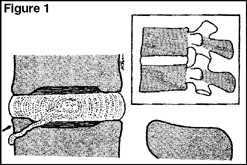The anterior intraosseous herniation of the nucleus pulposus producing a limbus vertebra was first described by Schmorl in 1927 and later in detail by Neidner.1 Despite the long interval since its first description, the abnormality is often misdiagnosed as a fracture.
Figure 1: A limbus vertebra.
The limbus vertebra in the adult is a rather common radiologic finding. In the child, it is a defect in the anterior margin of the vertebral body usually at the superior anterior margin of the vertebral body. The anterosuperior corner of a single vertebral body in the mid-lumbar region is most frequently affected. Most investigators accept Schmorl's opinion that the limbus vertebra resulted from an intrabody herniation of disc material. Schmorl's node is a more central herniation into the vertebral end plate, while the limbus vertebra is caused by a marginal herniation. The anterior herniation of the nucleus pulposus may cause a separation of a triangular smooth bone fragment which apparently represents the ring apophysis. This apophysis then remains separate from the vertebral body.
It has been stated that the anterosuperior margin of the vertebral body is more frequently affected because of the difference in size of the adjacent vertebral bodies, the upper one being smaller. As a result, during flexion, the anterior portion of the disc would be forced into the superior end plate of the larger inferior vertebra. Diagnosis of the limbus vertebra may be less difficult in adults since a well formed triangular fragment is present; in children or adolescents, only an irregular destructive-appearing process is present on the vertebral margin. No further investigative procedures are necessary, and treatment should be conservative.
Reference
1. Neidner F. Zur kenntnis der normalen und pathologischen der wirbeklorperrandleisten. Fortschr Rotgenstr 1932;46:628.
Click here for more information about Deborah Pate, DC, DACBR.






